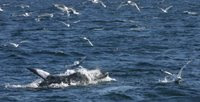 Well I've been a bit silent since the end of the trip - our heads are down analysing the data collected during the survey. Two tasks underway at the moment (1) writing a paper from the analysis of the IMPRESS* North Sea data looking at changes in the feeding behaviour of sandeels (picture shown above) and kittiwakes (picture shown on right)
Well I've been a bit silent since the end of the trip - our heads are down analysing the data collected during the survey. Two tasks underway at the moment (1) writing a paper from the analysis of the IMPRESS* North Sea data looking at changes in the feeding behaviour of sandeels (picture shown above) and kittiwakes (picture shown on right)  over tidal and diurnal (i.e. changes over day-night) cycles**, and (2) analysing the fish data collected in July firstly to determine species composition, and then to look at changes in species schooling behaviour with time of day, tides (high/low tides as well as spring-neaps). We're hoping to have the paper submitted by Christmas, and the preliminary James Cook data processing done by January. At the end of January we have a James Cook workshop in the lake district where we will present all our findings to date and hopefully find out how all the different bits (turbulence, dye dispersion, plankton, benthos, fish, seabirds) link together & tell us a more complete story of what's going on down in the Celtic Sea.
over tidal and diurnal (i.e. changes over day-night) cycles**, and (2) analysing the fish data collected in July firstly to determine species composition, and then to look at changes in species schooling behaviour with time of day, tides (high/low tides as well as spring-neaps). We're hoping to have the paper submitted by Christmas, and the preliminary James Cook data processing done by January. At the end of January we have a James Cook workshop in the lake district where we will present all our findings to date and hopefully find out how all the different bits (turbulence, dye dispersion, plankton, benthos, fish, seabirds) link together & tell us a more complete story of what's going on down in the Celtic Sea.* IMPRESS = Interactions between the Marine environment, PREdators and prey: implications for Sustainable Sandeel fisheries: a project Beth Scott was previously involved in & from which sandeel data was available to analyse
** This work was presented in September at the ICES (International Council for the Exploration of the Seas) conference in Halifax, Nova Scotia.


Figure 3 - Typical echogram of sendeel schools - so recall we're travelling from left to right, the bottom green line shows the seabed, and the top red line is the echo from the surface. The sound is bouncing back off these sandeel schools. The photo on the right shows a feeding aggregation of kittiwakes (and a few other seabird species) that occur when the sandeels are found at the surface.
So we're busy beavering away...
At the end of October we had a meeting with NERC and DEFRA to meet the other 5 projects funded under the sustainable marine bioresources program. It's a really interesting and diverse array of projects:
(i) modelling interactions between top predators and fishing vessels - looking at the overlap between seal foraging and fishermen using satellite tags both on the top of the heads of seals and on the fishing vessels.
(ii) new production in the North Sea deep chlorophyll maximum - similar to our study they have been analysing the sub-surface chlorophyll levels that exist at the thermocline but throughout the whole of the North Sea. They are then linking this to the rest of the North Sea ecosystem from zooplankton to fish.
(iii) a spatially resolved ecosystem model for the assessment of fisheries - by linking our understanding of how oceanography influences the growth and migrations of fish, these models are able to model the dispersion and age-structured distribution of fish stocks.
(iv) population structuring of cod around the UK - by taking DNA samples of lots of different cod from around the UK it is possible to determine how much genetic mixing there is between populations, by then comparing this to tag data on cod (they can tag fish!!!) they can see how this compares to the actual movement patterns of the cod (they make quite big migrations!).
(v) climate change and macroecological patterns in an exploited marine fish assemblage - a topical subject modelling benthic fish communities with environmental variables over time to see what effect climate change may be having on fish communities.
So, it's a really interesting group of projects & very exciting work! So I better get back to my paper writing & analysis... deadlines to make! Watch this space for progress...


No comments:
Post a Comment